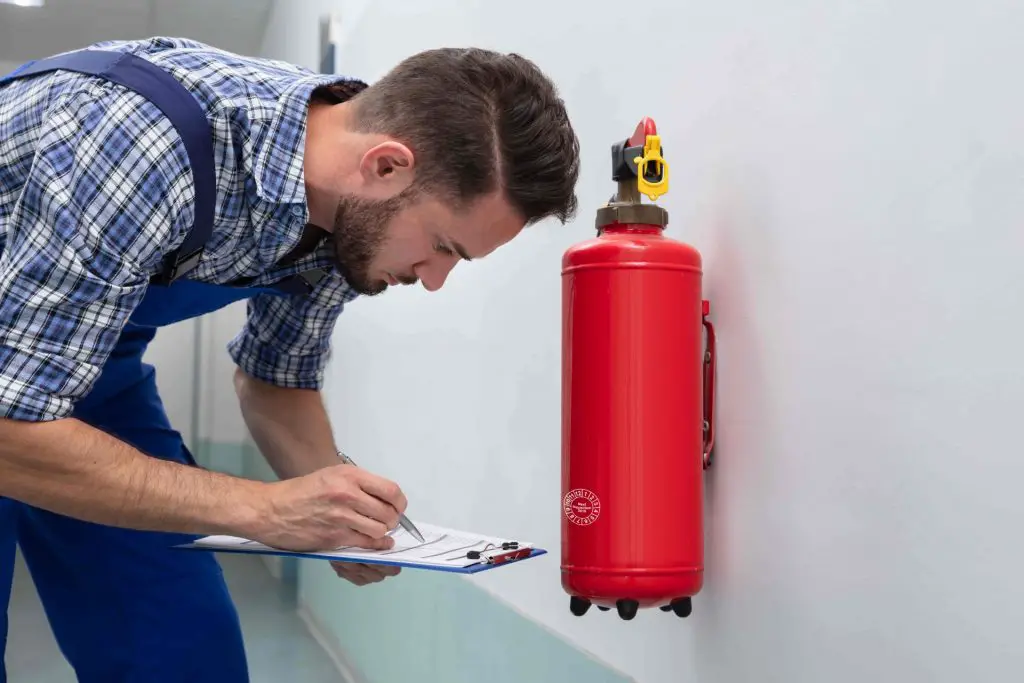Contents
- What do you do with old fire extinguishers?
- How Long Do Fire Extinguishers Last?
- Signs That Your Fire Extinguisher Needs to be Replaced
- How to Dispose of Fire Extinguisher
- #1. Extinguishers That Can’t Be Refilled or You Don’t Want to Refill Them
- #2. Extinguishers with Content
- #3. Empty Extinguishers
- Tips for Maintaining a Fire Extinguisher
- Final Thoughts
What do you do with old fire extinguishers?
- Once you’re sure your extinguisher is empty, and can’t be refilled, you are prepared to discard it
- Check in on local city guidelines– for example, NYC recommends that old fire extinguishers that are not dry chemical or carbon dioxide may contain carbon tetrachloride, a known carcinogen, need to be recycled by a local FDNY-certified fire extinguisher retailer.
- Recycling: According to NYC guidelines, after they have been emptied and released of their pressure, carbon dioxide and dry chemical extinguishers are safe to be recycled with bulk metal. To ensure you have properly emptied your fire extinguisher, follow the National Fire Protection Association’s (PASS) technique.
One of the ways you can keep your property safe is by installing a fire extinguisher. It’s designed to put out or contain small fires until the professionals arrive. But the real challenge usually comes when the extinguisher reaches the end of its lifespan. What do you do with it then? And when do you even tell that it’s time to recharge or dispose of?
If you are asking these questions, you are in luck as we will tell you the proper way of disposing of fire extinguishers and other useful information. Read on to learn more.
How Long Do Fire Extinguishers Last?
Most people, after installing the fire extinguishers, usually forget about them. However, they need regular maintenance, or they won’t work to the fullest potential.
Unfortunately, like most things, fire extinguishers don’t last forever. Experts say that they become less effective when the chemicals inside lose their charge or when the pressure drops. Although the exact lifespan depends on the model and brand, the National Fire Protection Association (NFPA) says that rechargeable models should be recharged after 6 years while disposable should be replaced after 12 years of use.
Bear in mind that most manufacturers don’t set a specific date for when the device expires. But, how long it will last depends on the care and maintenance. All in all, even the most cared for ones won’t last forever, which is why you need to know the date it was built and the manufacturer’s advice on when to replace it.
Signs That Your Fire Extinguisher Needs to be Replaced
Disposing of extinguishers should come as the last resort. Before then, we advise individuals to determine first whether they can still be used or recharged. That calls for a visual inspection from a professional fire safety technician, although some people take the task into their hands.
One way to tell that your extinguisher has expired is if it has lasted for more than 15 years. Note that these devices have a lifespan of between 5-15 years. If you are unsure of when you bought yours, check on its label or at the bottom to determine the manufacturer’s date. If you find out that yours has been manufactured more than 15 years ago, find out how recently it was serviced and the wear and tear level to help you decide if it is still operational.
When inspecting, watch out for signs of visual damage. You need to replace your extinguisher if you notice:
- Any leaking
- Corrosion or rust
- A wobbly or broken handle
- A missing or unsealed locking pin
- A blocked, cracked, or ripped hose or nozzle
- A missing hang tag or inspection sticker
Also, remember to inspect the pressure gauge monthly, especially if you live in a rented apartment. For instance, if its needle is inside the green area, the device is in perfect working condition. But if it’s in another place, it’s time for a replacement. Also, check the inspection sticker to see whether the hangtag is missing. If it is, please replace the cylinder immediately. Lastly, check for wear and tear, including the signs we have mentioned above.
How to Dispose of Fire Extinguisher

If you learn that your current extinguisher needs a replacement, the next challenge will be what to do with it. Note that these devices have pressurized chemicals. As such, you cannot simply throw yours in the garbage. Instead, you should take several steps to ensure that you are disposing of it safely. The right disposal method will depend on the condition of your fire extinguisher.
Nevertheless, here’s how to dispose of different types;
#1. Extinguishers That Can’t Be Refilled or You Don’t Want to Refill Them
- Take the extinguisher in an open area, then shoot a small amount outside to release pressure in the canister. Always ensure that you are wearing safety clothing.
- Leave the canister outside for some days to make sure that pressure is released completely.
- With no pressure inside, you can now throw it in the regular garbage or trash bag.
#2. Extinguishers with Content
Inspect the pressure gauge to determine the level of content inside. You can learn whether you have an overcharged unit, the right pressure level, or whether you need a recharge from this inspection. If the gauge shows that the pressure is not correct, you will need refilling or recycling. In that case, your best solution will be to reach out to the Department of Public Works in your area to know when they are conducting the next waste collection. Then you can have them pick your extinguisher, which has content in the cylinder.
#3. Empty Extinguishers
- Release any pressure inside by squeezing the lever
- Remove your extinguisher’s head from the cylinder to show that it is not charged
- Reach out to a local recycling facility to drop off the cylinder
If you aren’t sure whether your cylinder can be recycled, search online for recycling centers within your location and ask them.
Tips for Maintaining a Fire Extinguisher

- Proper maintenance is needed for your extinguisher to last for the years it was intended to. Here are some maintenance tips;
- During the inspection, clean the outside to ensure that the cylinder doesn’t have grease, dirt, or oil.
- Protect the unit from any dents, especially on the handle and nozzle.
- Record every time you inspect your cylinder and take note of its pressure.
- Keep your extinguishers away from heat and chemicals. But ensure that the place is easily accessible.
Final Thoughts
A fire extinguisher plays an essential role in fire prevention and is part of the protocol for childproofing a fireplace. However, when it’s expired or malfunctioned, it risks the lives of the people around and the structural integrity of the nearby property. It’s why you need to practice regular maintenance for these security devices. Also, we recommend having professional fire prevention personnel conduct regular inspections.
Bear in mind that you can’t fix components of an extinguisher. The only thing that can be replaced is a safety inspection tag. However, if other parts of your extinguishers are broken, you will most likely need to buy a new one.

